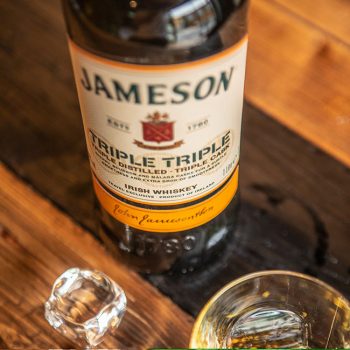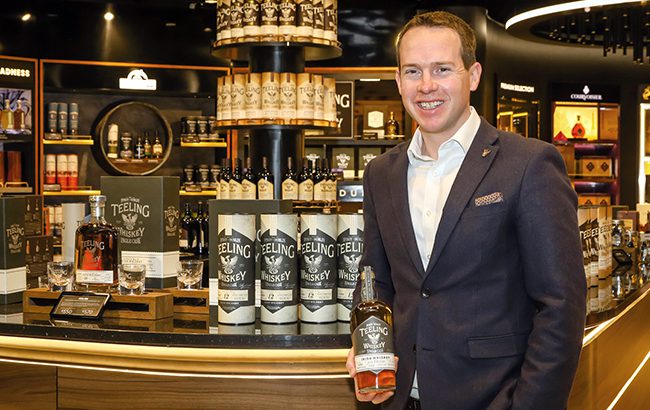Irish whiskey in travel retail: recovery begins
Having been stymied by pandemic shutdowns, Irish whiskey brands are planning to capitalise on the return of travellers to duty free outlets in the world’s airports. We discover how producers are planning to attract consumers.

Holiday plans can once again be part of everyday conversations. After two years of being largely grounded by the Covid-19 pandemic, vaccinations and social adaptations mean many consumers have been able to take to the skies and venture abroad.
For Irish whiskey brands that see the global travel retail (GTR) channel as a gateway to attracting international audiences, the progress is welcome. The past two years have been extremely taxing for the category. In 2020, it suffered colossal sales declines, plummeting by almost 70% in volume and 71% in value, according to IWSR Drinks Market Analysis. This marked a stark contrast to the 5.9% volume growth and 8.4% value growth in 2019 before the pandemic.
While the 2021 data is not yet available, IWSR expects Irish whiskey in GTR to grow by a compound annual growth rate (CAGR) of 33% between 2021 to 2025, and by almost 37% in value CAGR during the same period.
IWSR analyst Thorsten Hartmann offers some insight into the figures: “Largely normal patterns (if not traffic as a whole) resume – general airside duty free, dedicated airside whisk(e)y shops, airside branded boutiques, ferry shops, cross-border shops, and shops on cruise liners are coming back to life, and Irish whiskey is no exception. By and large, click-and-collect has not caught on, so physical shopping remains paramount.”
Pernod Ricard, owner of the world’s leading Irish whiskey brand, Jameson, has seen positive progress in the GTR channel. The company believes it is in a “strong position” to expand in GTR, and has seen “strong” recovery in the Americas – “particularly through our cruise business, as well as Western Europe, which has contributed significantly”, notes Liya Zhang, Pernod Ricard Global Travel Retail, vice-president of marketing.
“Interestingly, beyond Europe, the Pacific and the Americas, which are all well-established regions, we are also seeing increasing demand for Jameson in India,” Zhang adds. “In fact, the brand has grown by triple digits in the domestic market fiscal year to date, and this is projected to continue accelerating. We will also step up our presence in Southeast Asia to meet emerging demand, as well as plan for the opportunity and accelerating interest in our prestige offering in the wider Asia region.”

Airport presence remains important for Dublin-based Teeling, which has carried out two activations in airports this year, says Stephen Teeling, sales and marketing director for the company. One took place in January; the second, in March, was “very, very good”, he says. “We hadn’t seen American passengers in substantial numbers in a long time, but the split of US passengers swung again at around 30%-40%, which was great,” he recalls. “At the start of March things picked up in GTR, and it has continued for us.”
Teeling continues to see value in new product launches in GTR, and debuted Teeling Whiskey – The Vintage Reserve Collection in China Duty Free Group in Hainan, China, in February.
The range comprises three rare Irish single malt whiskeys: Teeling 38 Years Old Single Malt Very Rare Cask; Teeling Whiskey 32 Years Old Single Malt Rum Cask; and Teeling Whiskey 2001 Vintage Reserve Single Cask.
Teeling notes China’s resilience in GTR during the pandemic. “China sustained a lot of the business, and it really surprised us during the pandemic how much it ran for us,” he says. “Everyone says China is a big opportunity for Irish whiskey but it’s still quite small for Irish whiskey.”
Pernod Ricard is also focused on new innovation in the GTR channel. In the next year, the company intends to launch new Jameson GTR expressions, and further bolster the brand’s growth.
“We are excited to share our innovation pipeline with our retail partners,” Zhang notes. “These will be showcased both in our Taste House at Dublin Airport and further afield, with a focus on expanding our ultra-premium and prestige segments. Importantly, we will also retain a special focus on exclusive and limited editions in our brand home of Dublin, where we know there is an ever-evolving appetite for newness.”
Newcomers enter channel
The challenges the pandemic has presented to GTR have, encouragingly, done little to dissuade newcomers from entering the channel. Richard Lombard-Chibnall, founder of The Molly Malone Whiskey Co, remains optimistic about GTR’s potential to expand his company’s global presence, both in duty free and domestically.
In April this year, Molly Malone Small Batch made its travel retail debut through Aer Rianta International at Dublin Airport, which is primarily aimed at Irish-American travellers. The company appointed Garry Maxwell, of Gmax Travel Retail, to handle the brand’s expansion in the duty free sector.
“Travel retail is very competitive; Irish whiskey is on fire,” says Lombard-Chibnall. “The travel market is coming back. Molly Malone smacks of Dublin, so this was the perfect launch location for us. It started slowly but is picking up now. We’re waiting for the American market to really start flying back as well.”
Lombard-Chibnall believes success in the GTR channel ultimately leads to success domestically. “Both complement each other,” he says. “Exposure in the travel retail market will help create the brand, which will then drive domestic demand as well. That’s what we intend to do in the US with border stores; it’s all part of our bigger plan.”
However, analyst Hartmann still notes some minor setbacks that could hinder Irish whiskey’s rebound in GTR. “There is still some reluctance on the part of operators (or their landlords) to allow in-shop tastings – where these are once again allowed, they appear to have morphed from poured tastings to offering takeaway tasting minis, i.e. slightly reducing the opportunity for interaction,” he adds.
“On-site brand ambassadors are also still few and far between. This means that travellers by and large deploy two techniques – informing themselves of spirits offerings (and their relative prices at points of departure, arrival and, indeed, landside duty-paid).
“Otherwise, it’s the usual browsing of shelves in captive time or, where available, enhanced engagement with brands where special displays and/or digitally interactive interfaces are being deployed.”

Further digital acceleration will be crucial to GTR success, believes Teeling. While the industry has made strides to be more tech-savvy in the GTR channel, there is still a long way to go, he adds.
“The Chinese are light years ahead of us digitally; they’re very impressive,” Teeling says. “In Asia, digital is massive, it’s digital first, and has been for the past four or five years. Asia has been actively engaging with people before they travel through airports. They would offer consumers options to browse before they came to the airport, whereas for us, the tradition was more waiting until they came to the airport, and stepping into the shop. But now everyone has a phone, everyone is browsing and shopping online, so we’re adapting and moving to tap into that pre-travel potential.”
Pernod Ricard GTR’s Zhang concurs, and stresses that the future of e-commerce in the channel will depend on a mix of in-store and digital experiences.
“We believe that e-commerce is essential to the continued recovery and growth of the channel,” Zhang says. “As younger travellers make up a growing share of passengers post-pandemic, the industry must focus on providing digital-first experiences that merge online and offline worlds for Gen Z and Millennials.
“Rather than e-commerce becoming the future of the channel, our ambition is to blend e-commerce and in-store experiences to create a ‘phygital’ approach that is both omnichannel and profoundly 360.”
Teeling also notes the greater importance of duty free since Brexit. With the right engagement, before airport arrivals and after, Teeling envisions a “huge scale opportunity for Irish whiskey”.
He enthuses: “Irish whiskey is still in a phase of dynamism,” and reveals further planned GTR launches this year – including an exclusive with Dufry.
“The category is growing and it’s still new for a lot of people,” Teeling adds. “Explorers Edition was about finding interesting casks through travelling. We’re hoping to launch another expression towards the back end of this year. We’ve got three or four other travel retail projects in the pipeline, including an extension of the Ambassadors Selection with Aer Rianta in Dublin. Hopefully we’re adding some value to our partners, and exciting customers as they come back through duty free. That’s our goal at the end of the day.”
Related news
Cocktail stories: Speed Bump, Byrdi
